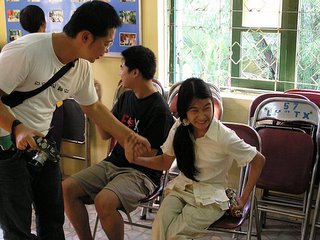
 アメリカ在住の山口 元さんが、支援隊ツアー参加の感想を寄せてくれました。左の写真(北村撮影)は、被害者の女の子に手を貸す山口さんです。 なお、日本語訳は北村。山口さんの英語原文は下におつけしておきました。併せてご覧下さい。北村
アメリカ在住の山口 元さんが、支援隊ツアー参加の感想を寄せてくれました。左の写真(北村撮影)は、被害者の女の子に手を貸す山口さんです。 なお、日本語訳は北村。山口さんの英語原文は下におつけしておきました。併せてご覧下さい。北村ベトナムとエージェント・オレンジ
私は、2005年10月にフリー・ジャーナリストの北村元さん率いるスタディ・ツアーに参加して、ベトナムを訪問する機会を得ました。ツアーの目的は、ベトナム戦争時代のエージェント・オレンジの被害者の実態を学び、援助することでした。それほど遠くない昔に、私も日本とアメリカで学校教育を受けました。しかし、ベトナム戦争に関しては、重要なことは一切学んでいませんでした。事実、各種の報道は、他の誰よりも私に多くの情報をもたらしてくれました。しかし、ここでもベトナムや国民が受けたことを理解するに十分なものはありませんでした。
私がハノイに着いた時、町が生き生きとしているのに驚きました。ハノイの町には人が溢れ、道路はバイクと車で一杯でした。どの通りの角にも、小さなカフェや食堂が並んでいました。しかしながら、無秩序な交通の流れと地元の人々が元気に行き交う風景のなかで、私はいくつかの不思議な光景に気づきました。新車のベンツやBMWを運転している人たち。高級店で買い物をする姿。5ッ星のホテルレストランで食事をする人たち。これらの光景は、社会経済・政治制度の副産物に違いないと、私は思ったのです。
枯れ葉剤の核心にはダイオキシンが含まれていたのです。私は、初めてその恐ろしい影響について知るに至りました。エージェント・オレンジとその毒性に冒された元兵士、普通のお父さん、お母さん、息子たち、娘たちに会いました。ダイオキシンの毒性は、時間と共に影響が薄れたり消滅するのではないことがわかりました。第三世代の子どもが、未だに目に見える恐ろしき兆候を見せているからです。
ダイオキシンの毒が、若きも老いも区別なく、如何に人間の体をむしばんだかを私自身が目にすることは辛いものがありました。スタディ・グループとして、私たちは枯れ葉剤の影響をみるためにハノイ周辺や近くの省を回りました。私たちは、個人の家も、またダイオキシンの被害者を収容している施設も共に訪問しました。子どもたちは奇形で生まれるか、精神的影響を受けて生まれていました。一見“正常にみえて”も、複数のガンや他の疾病に冒されていました。とりもなおさず、戦争中にダイオキシンを使用したことに正当性がないばかりか、なぜ無実の子どもたちが苦しまなくてはならないのでしょうか?
私は、今もこのスタディー・ツアーで撮った写真の整理に追われています。ハノイの下町や生の姿に愉快な写真もあります。しかし一方で、枯れ葉剤の影響とその後遺症を写しだした画像もあります。未だに、私がベトナムで観たこと、経験したことは信じがたいことです。そして、どうしたらいいのかわかりません。しかし、私自身ができることはわかっています。それは、いま起きていることをもっともっと写真に撮ること、戦争とダイオキシンの影響を受けた人の写真を証拠で示すことです。そして、他の多くの人にこれらの写真をみてもらうこと、言い換えれば、世界に“メッセージ”を送ることです。そうすれば、やがて世界の人々は、社会的にも道義的にも気づき、将来にあらざる破滅の再発を防ぐことになるのではないかと思うのです。
2006年1月
山口 元(げん)
Vietnam and Agent Orange:
I had an opportunity to visit Vietnam in October of 2005 with an educational tour group led by a freelance journalist Mr. Hajime Kitamura. The purpose of the tour was to learn and help out victims of Agent Orange from the Vietnam War. In the not-so-long ago past, I’ve received formal education in both Japanese and American systems, but I didn’t learn anything significant regarding the Vietnam War. In fact, the media had informed me more on the subject matter than anyone else. But then again, it was nowhere near sufficient to understand what the country and the people had gone through.
When I arrived in Hanoi, I was surprised to see how energetic the city was. People filled the city and its roads with bikes and cars. Small coffee shops and food stalls were set up on every street corners. However, amongst the chaotic traffic and the lively interactions of the locals, I realized several odd things. I frequently saw locals driving brand new Mercedes and BMWs, shopping in expensive designer stores and dinning in five-star hotel restaurants, usually catering towards the foreigners. I thought these must be the byproducts of the socioeconomic/political system.
Agent Orange, AKA, Karehazai in Japanese was composed with Dioxin as a centerpiece, and I got to learn about its deadly effects first hand. I witnessed ex-soldiers, regular mothers and fathers, sons and daughters who were affected by Agent Orange and its toxin. I learned that the poison of Dioxin does not subside nor disappear with time, for it is evident that 3rd generations are still showing visible deadly signs of it.
It was troubling for me to see how the poison of Dioxin destroyed humans, both young and old indiscriminately. As a study group, we went around Hanoi and near by provinces to see the aftermath of Agent Orange. We visited both, independent households and institutions that housed the victims of Dioxin. Children were born with deformities and/or with mental retardation. While others ‘looked’ normal but suffered from multiple cancers and other diseases. There is no justification for employing Dioxin during the war in the first place, but why should innocent children suffer?
I am still in the midst of organizing the images that I took from this trip. Some are pleasant pictures of downtown Hanoi and its liveliness, whilst other images depict the effect of the Agent Orange and its infamous legacy. It’s still hard to believe what I saw and experienced in Vietnam. And I am not sure to what can be done, but I know what I can do. It is to take pictures, more pictures of what is happening, to document images of people who are affected by the war and Dioxin. And to share these images with others, in other words, to deliver a ‘message’ to the world. Then maybe, people will become aware, socially and morally, and hopefully prevent unnecessary future catastrophes from happening again.
Gen Yamaguchi
January 2006


0 件のコメント:
コメントを投稿